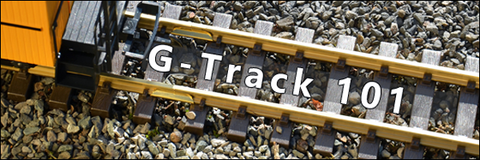Track Facts 1: What Metal is The BEST?

Track Facts: A Series Explaining the Truth Others Don't Want You to Know.
What Metal is The BEST Choice For Rail?
If you want to know track, first you want to start with the options for electrical conduction. Electrical conduction is basically the passage of electricity through a medium, or conductor. (Not a train conductor, a material. 😊)
There are a few well-known, and readily available, metals used for electrical conduction...
Silver – Silver is one of the most conductive metals on Earth. This is because silver only has one valence electron. This single electron is free to move around with little resistance. As a result, metals like silver and copper are a few of the metals with this particular characteristic which makes them great for electrical and thermal conduction. Of course, silver is too expensive for use in G-Scale track.
Copper – Copper, like silver, only has one valence electron which makes this metal very conductive. (This is why high-end cookware commonly has a coating of copper.) Copper is also a soft metal, which makes it nicely flexible for electrical wiring.
Gold – The combination of gold’s resistance to corrosion and its excellent conductivity make this metal an extremely valuable resource used in the electronics industry. But gold is obviously not a cost-effective solution for track.
Aluminum – Overall, aluminum is an excellent conductor for heat and electricity. The high heat conduction is especially noticeable over time, in that the metal gets hotter the longer current is active. Aluminum wiring caused electrical fires in many homes built in the 1960's, which is why it is no longer used. Aluminum is also not a highly durable metal for G-Scale rails. It is comparatively soft and pliable. Stepping or dropping something on aluminum rails could easily damage them and aluminum can be easily worn down by the harder metal wheels of the trains.
Finally, aluminum exposed to the elements starts forming aluminum oxide, called alumina, within minutes. Alumina, once coating the rails, results in a very poor electrical conductor. In fact, alumina is actually used as an electrical insulator, the exact opposite of what is wanted for track-powered trains.
Brass – Brass is an alloy. The specific brass alloy used for PIKO G-Track rails is a mixture mostly of copper and zinc, with a small percentage of lead. While brass is technically less conductive than these other four metals, its durability and resistance to the elements increase its value for G-Scale rails. This particular alloy is also known for its excellent machinability and malleability, such as fabricating the material into G-Scale rails.
The small percentage of lead is a necessary inert part of the alloy. Risk of exposure would mainly come from grinding up the rail and then handling or ingesting the dust, which is not something done in normal use. Many years ago, another brand was trying to sound concerned when they proudly proclaimed to all that they would seek to remove all lead from their rail. Of course, this produces a brittle, almost completely unworkable material that is virtually useless for rail.
Another Metal to Mention…
Nickel-Silver – In the model train world, Nickel-Silver has become a common rail material for smaller scales. It actually contains no silver. The name comes from the silvery appearance when clean. Nickel-Silver rail is an alloy made primarily of copper, nickel and zinc, with a small percentage of lead. It has a relatively high electrical resistance, so it loses considerable voltage over distance, and it has decent corrosion resistance. In the volumes needed to make a piece of G-Scale track, the higher price versus brass rail would make a big difference in your budget.
Metal Prices
Metal pricing fluctuates constantly, however we can give you a rough comparison of costs. PIKO uses a special grade of virgin brass that is one of the more expensive brass alloys. Still, it costs a fraction of some other conductors. As of this post:
Silver was over ten times the price of brass per pound.
Gold was over 400 times the price of brass per pound.
Aluminum was less than half the cost of brass per pound, which makes one wonder why the far less ideal aluminum rail costs as much as it does.
Nickel-Silver was more than double the price of brass per pound, enough to be quite unattractive in the sheer volumes of metal needed for big, durable, Code 332 G-Scale rail. Combined with the voltage loss over distance, this becomes a rather poor option for G-Scale.
Summary of Metals for G-Track
All things considered, brass is by far the most ideal material for G-Scale rails. (That is, unless you want to pay for silver or gold rails!) We have noted that aluminum is not a durable metal - it conducts heat, is easily damaged and wears quickly. Stainless steel - another metal that has been promoted for G-Scale track - is a 40-50% less efficient conductor than brass, is more expensive, is hard to work with, rapidly wears wheels, and expands and contracts far more with temperature changes. Nickel-Silver is more expensive and has voltage loss over distance. So, brass rail is the clear winner due to durability/longevity, conductivity, ease of use, ease of maintenance and price!
But all brass is not created equal! More about that next time...





